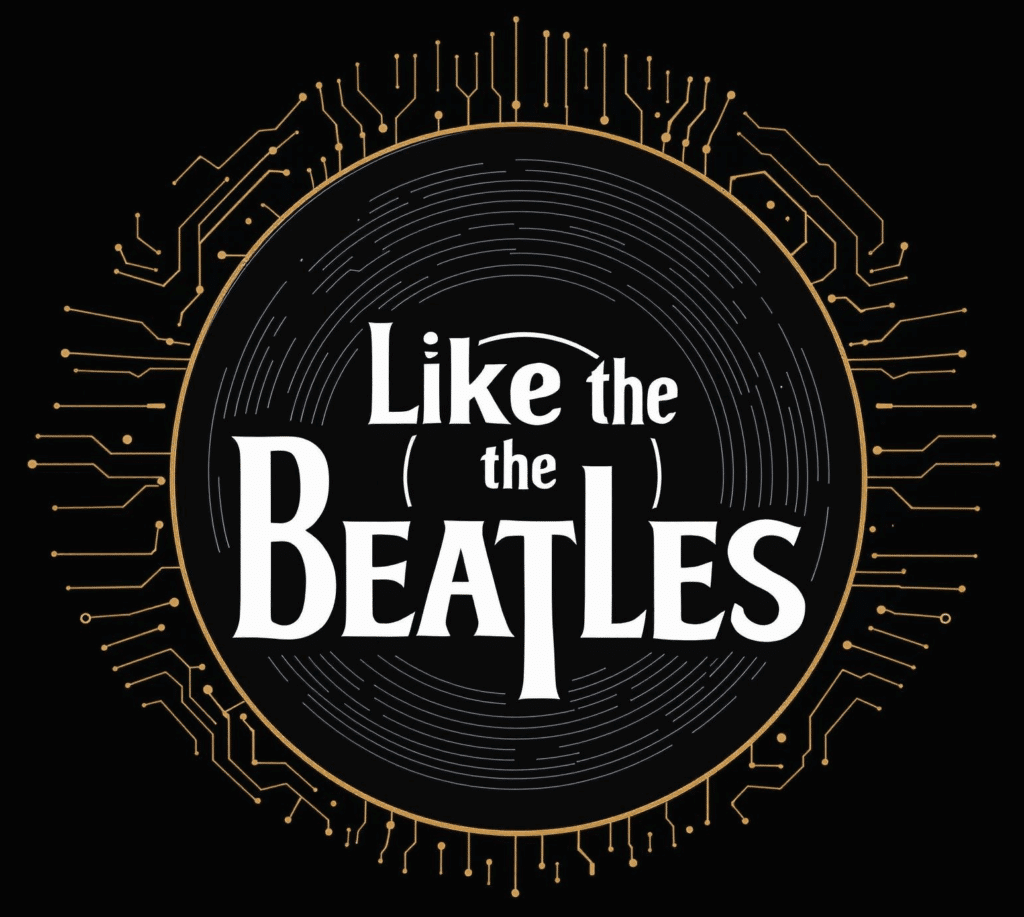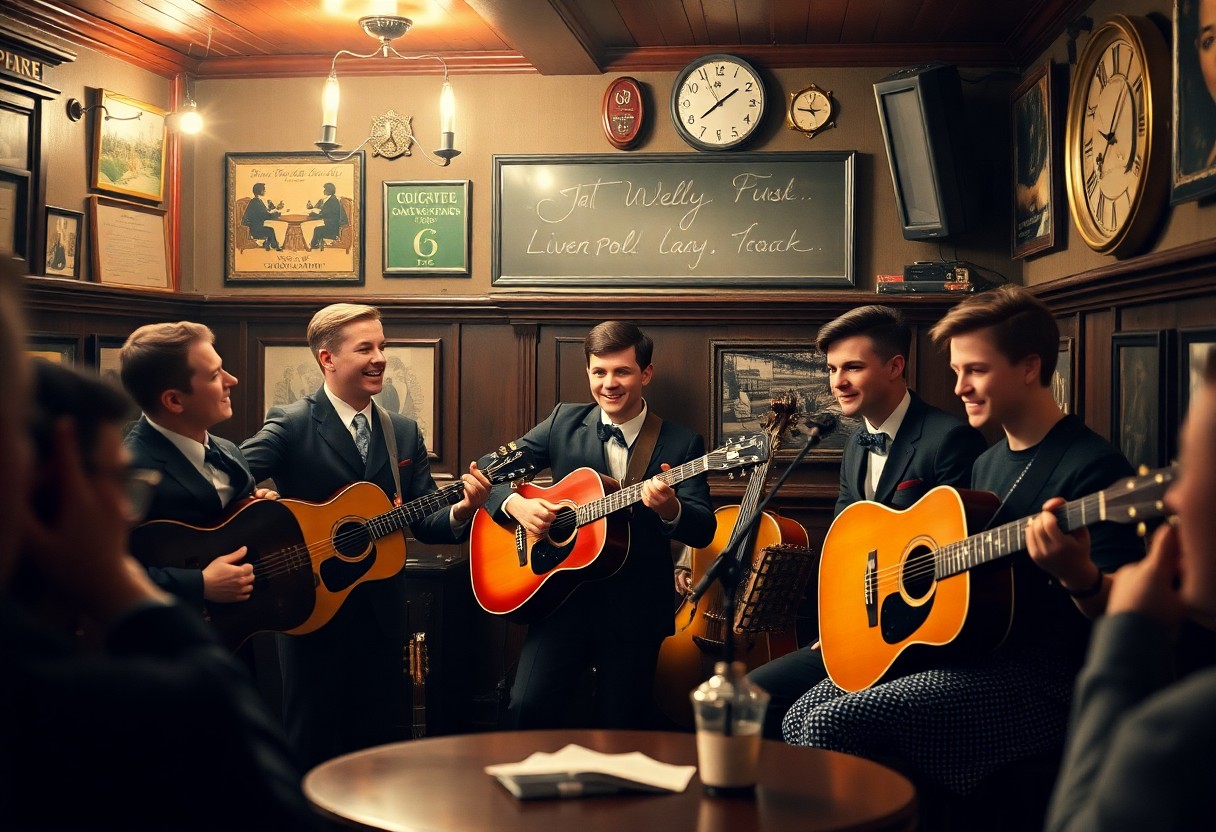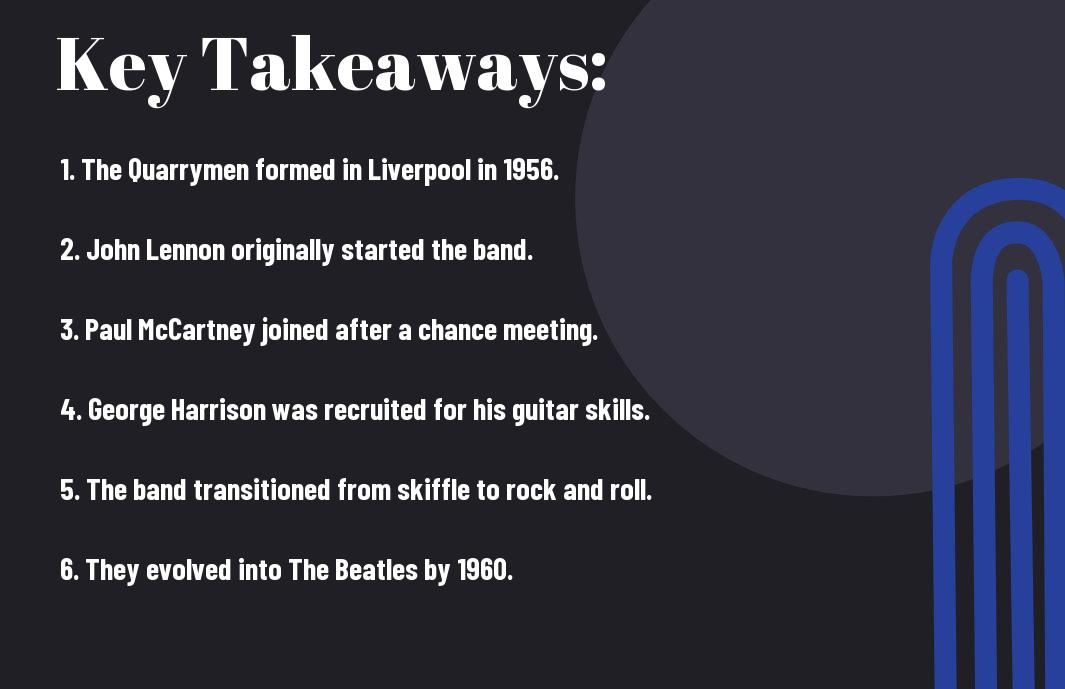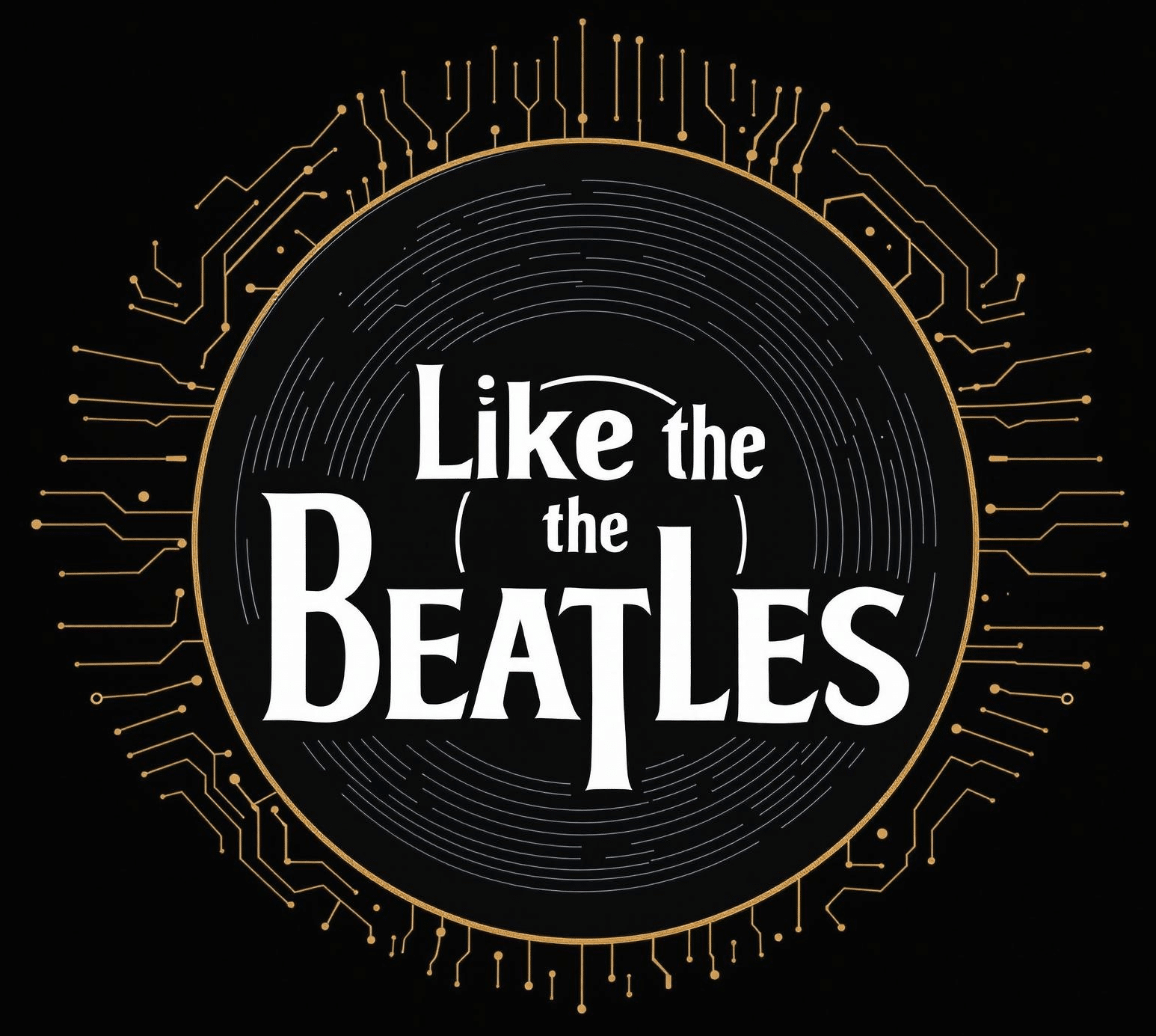Just as music transcends time, the journey of The Quarrymen evolving into The Beatles is a fascinating story of creativity and transformation. In this post, I will guide you through the pivotal moments and key players that shaped their musical path, shedding light on how a simple skiffle band became one of the most influential groups in music history. You’ll discover the early challenges they faced, the groundbreaking decisions they made, and the undeniable impact they’ve had on popular culture today. Join me in tracing their remarkable roots.
The Formation of The Quarrymen
While the journey of The Quarrymen began in 1956, it was the aspirations of a young John Lennon that laid the foundation for this iconic band. Captivated by the emerging sounds of rock and roll, Lennon gathered friends to form a skiffle group that would ultimately pave the way for one of the most revolutionary music acts in history. The name ‘The Quarrymen’ paid homage to John’s school days, symbolizing a youthful spirit and ambitious dreams.
Early Influences
About this time, the influence of American rock and roll artists like Elvis Presley, Chuck Berry, and Little Richard started to permeate British music culture. These artists inspired me, as I sought to channel their energy and style into my own performances. The blend of skiffle rhythms with rock and roll melodies created a unique sound that resonated with my generation, fueling our desire to create something innovative.
Initial Performances
Influences from local bands and emerging rock sounds nudged us to take the stage and put our skills to the test. Initially, we performed at local venues and community events, honing our craft in front of eager audiences. Due to our youthful exuberance, we brought a raw energy to our initial performances that captivated listeners. Those early gigs—often at youth clubs and church halls—were instrumental in shaping our identities as musicians. Despite the rudimentary equipment and brief sets, the thrill of performing ignited a passion within me that would eventually blossom into the artistry of The Beatles.
Transition to The Beatles
Any discussion of the evolution of The Quarrymen into The Beatles emphasizes the transformative journey that shaped one of music’s most iconic bands. This period saw significant changes in their identity, image, and sound, aligning them closer to the cultural zeitgeist of the 1960s. The band was no longer just a local skiffle group; they were evolving into an influential pop phenomenon that would impact generations.
Name Change and New Members
The transition began with a name change, shifting from The Quarrymen to The Beatles in 1960. This rebranding coincided with the addition of new members, including the emergence of Ringo Starr, who brought a distinctive flair to the group. The lineup solidified into a powerhouse that combined diverse musical influences, laying the groundwork for their future success.
Stylistic Evolution
One of the most significant aspects of this transition was the group’s stylistic evolution. Initially rooted in skiffle and rock and roll, The Beatles began experimenting with a fusion of various genres that included pop, folk, and even classical elements.
Hence, as I investigate deeper into this transformation, I recognize the importance of innovation in their music. The Beatles adopted a more sophisticated approach to songwriting, characterized by complex harmonies and mature themes. This shift reflected their personal growth and the desire to transcend the limitations of their early sound. As they embraced new techniques and influences, they not only redefined their own identity but also reshaped the landscape of popular music itself, making a lasting impact on the industry and culture. This evolution was pivotal in establishing them as enduring icons in music history.
Key Milestones in the Band’s Journey
Many significant events marked The Quarrymen’s evolution into The Beatles, shaping their music and identity. From early performances in Liverpool to groundbreaking studio sessions, each step brought them closer to becoming a global phenomenon. Understanding these milestones helps illuminate the transformation of the band and its lasting impact on music history.
First Recordings
Among the band’s earliest recordings was the iconic demo of “Love Me Do,” which showcased their unique sound and distinct musical style. This pivotal moment set the stage for future success, drawing the attention of record labels eager to capitalize on their budding talent.
Rise to Fame
Fame came rapidly for The Beatles as their innovative approach to music captivated audiences worldwide. Their first major hit, “Please Please Me,” topped charts and propelled them into the limelight. The band quickly became symbols of a generation, defined by their vibrant style and innovative sound.
Journeying through the highs of public adoration, I found that the band’s unique blend of melody and lyrics resonated with fans in a way that was unprecedented. They faced challenges, including intense media scrutiny and personal rivalries, which only fueled their creativity. Their reputation soared with each new release, leading to their unforgettable appearances on television, such as ‘The Ed Sullivan Show,’ which introduced them to a broader audience. This all contributed positively to their influence on the music industry and culture at large, solidifying their place in history.
The Impact of The Beatles on Music
Your understanding of modern music isn’t complete without acknowledging the monumental impact The Beatles have had. They transformed the music landscape, paving the way for countless artists and genres. From pop to rock, their innovative techniques and catchy melodies redefined what was possible in songwriting and performance. Their approach to album production and the incorporation of diverse influences inspired generations of musicians to push boundaries and explore new creative avenues.
Cultural Influence
One cannot underestimate the cultural ripple effect The Beatles created during the 1960s and beyond. Their music resonated deeply with the youth of the time, leading to not only a musical revolution but also influencing fashion, art, and social movements. They became icons of the counterculture, promoting ideals of peace and love that defined an era. Their global reach solidified the role of music as a unifying force across cultures and generations.
Innovation in Sound
Before The Beatles, popular music adhered to traditional structures and sounds. However, they broke away from these conventions, utilizing innovative recording techniques and experimenting with various musical styles. They embraced multitrack recording, allowing for richer soundscapes and complex arrangements. Their use of non-traditional instruments, such as the sitar and string quartets, expanded the auditory palette of popular music, inviting endless possibilities for creativity.
Sound experimentation was a hallmark of The Beatles’ evolution as a band. They probed into genres such as psychedelic rock and avant-garde compositions, incorporating techniques that were once deemed unconventional. Their landmark album, “Sgt. Pepper’s Lonely Hearts Club Band,” showcased their mastery of studio production, blending sounds and layers to create a cohesive yet highly diverse listening experience. This innovative spirit not only established a new standard for music production but also encouraged aspiring artists to explore and embrace their own sonic identities.
The Legacy of The Quarrymen and The Beatles
Unlike many bands that fade into obscurity, the Quarrymen and their transformation into The Beatles have left an indelible mark on music history. Their innovative sound and captivating compositions continue to inspire artists across genres. This legacy showcases the band’s pioneering spirit and enduring influence in popular culture, demonstrating just how revolutionary their journey was from humble beginnings to global icons.
Lasting Influence on Future Artists
Quarrymen paved the way for countless musicians, shaping the landscape of modern music. Their unique blend of rock, pop, and experimental sounds can be heard in the works of both contemporary and future artists. Everyone from indie bands to pop sensations draws inspiration from their groundbreaking techniques and catchy melodies, ensuring their influence will continue to resonate for generations.
Preservation of Their Story
Between dedicated fans, historians, and various media, the story of the Quarrymen is diligently preserved. Numerous documentaries, books, and musical retrospectives have chronicled their journey, emphasizing the importance of their contributions to music.
Future efforts to maintain this narrative ensure that the rich history of the Quarrymen will not be lost to time. By safeguarding their journey, we continue to celebrate the incredible transformation that led to the birth of The Beatles. This ongoing commitment has a tangible impact, as it allows new generations to appreciate the remarkable origins of this legendary band and the profound effect they had on the evolution of music. The Quarrymen’s story is not just about nostalgia; it’s an necessary part of our cultural heritage that deserves to be shared and cherished.
The Evolution of Their Music
Once again, the metamorphosis of The Quarrymen into The Beatles can be traced through their distinct musical evolution. Starting with their initial influence from skiffle, they integrated various genres, paving the way for an innovative sound that would captivate audiences worldwide. This gradual transformation not only showcased their versatility but also reflects the cultural changes of the era, setting the stage for their iconic status in music history.
From Skiffle to Rock
Evolution marked the transition from skiffle, a genre rooted in folk and jazz, to the electrifying rock sound that characterized The Beatles. As they explored different musical instruments and styles, their songwriting matured, and their songs began to resonate with a broader audience.
Experimentation and Growth
Beside their development in musical style, The Beatles ventured into uncharted territory with their songwriting and production techniques. Their willingness to experiment with diverse musical elements, such as incorporating orchestral arrangements and unconventional instruments, helped reshape the landscape of popular music. From their early days in the Cavern Club to the cutting-edge sessions at Abbey Road, I witnessed how their evolving sound reflected their innate creativity and desire for growth.
Your understanding of their musical journey expands as you realize their willingness to embrace change. Their collaborations with avant-garde artists and the exploration of new technologies, like tape loops and multi-track recording, showcased their commitment to pushing artistic boundaries. This fearless experimentation lent an authenticity to their work, allowing them to tackle complex themes while retaining their universal appeal. As The Beatles evolved, so too did their music, leading to masterpieces that still resonate with fans today.
Summing up
Ultimately, examining the evolution of The Quarrymen into The Beatles reveals a fascinating journey marked by creativity, experimentation, and collaboration. I believe understanding this transition not only highlights the band’s musical growth but also reflects the broader cultural shifts of the era. By tracing their early influences and transformations, you can appreciate how these formative years shaped the iconic sound and legacy of The Beatles, inviting you to explore the rich history behind one of the greatest bands of all time.












